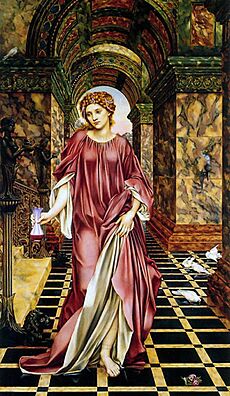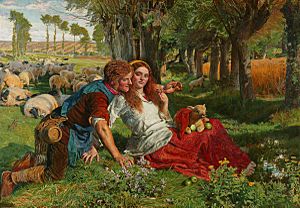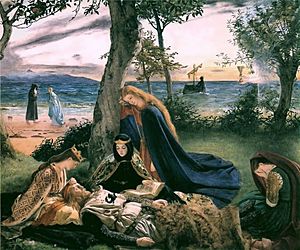Pre-Raphaelite Brotherhood facts for kids
The Pre-Raphaelite Brotherhood, also known as the Pre-Raphaelites, was a group of young English artists, poets, and critics. They formed their group in 1848. The main founders were William Holman Hunt, John Everett Millais, and Dante Gabriel Rossetti. They wanted to change the art world of their time.
The group was a "Brotherhood" of seven members. They were inspired by an earlier German art group called the Nazarene movement. Many other artists and poets shared their ideas, like William Morris and Edward Burne-Jones.
The Pre-Raphaelites loved the art from Italy before the famous artist Raphael. This early Italian art, from a time called the Quattrocento, was full of bright colors, lots of detail, and interesting scenes. The group felt that art had become too boring and stiff after Raphael. They especially disliked the style of Sir Joshua Reynolds, the founder of England's Royal Academy of Arts.
The group believed that art should be about real ideas and feelings. They studied nature carefully to make their paintings look realistic. They also published a magazine called The Germ to share their ideas. The original Brotherhood only lasted for about five years, but their influence continued for a long time.
Contents
How the Brotherhood Began
The Pre-Raphaelite Brotherhood started in 1848 at the house of John Everett Millais's parents in London. The first members to meet were Millais, Dante Gabriel Rossetti, and William Holman Hunt. Hunt and Millais were students at the Royal Academy of Arts.
Rossetti was also a poet and wanted to connect poetry with painting. Soon, four more members joined them. These were the painter James Collinson, the critic Frederic George Stephens, Rossetti's brother William Michael Rossetti, and the sculptor Thomas Woolner. This brought the group to seven members.
They asked an older artist, Ford Madox Brown, to join, but he decided to stay independent. However, he was a good friend to the group and supported their work. The Brotherhood wanted to keep their group a secret from the leaders of the Royal Academy at first.
What Did the Pre-Raphaelites Believe?
The group had four main goals for their art. William Michael Rossetti wrote them down:
- To have real and interesting ideas to share.
- To study nature closely to know how to paint it.
- To appreciate art that is honest and heartfelt, not art that is just following old rules.
- Most importantly, to create excellent paintings and sculptures.
The Pre-Raphaelites were inspired by the Middle Ages. They felt that medieval art had a special spiritual and creative quality. They tried to combine this with a realistic style, where they painted nature exactly as they saw it.
Later, the group split into two main styles. One group, led by Hunt and Millais, focused on realism. The other group, led by Rossetti, focused more on medieval stories and legends. Even though they had different styles, both groups believed that art should have a spiritual meaning.
To make their colors incredibly bright, Hunt and Millais used a special technique. They painted thin layers of color over a wet, white background. This made the colors shine like jewels. They did this because they disliked how older artists used a dark, tar-like substance called bitumen, which made paintings look muddy.
Showing Their Art to the World
The Pre-Raphaelites first showed their work to the public in 1849. Millais's painting Isabella and Hunt's painting Rienzi were shown at the Royal Academy. Rossetti's The Girlhood of Mary Virgin was shown at a different exhibition.
To show they were part of the group, each member signed their work with their name and the letters "PRB" for Pre-Raphaelite Brotherhood.
In 1850, the group also started a magazine called The Germ. It included poems by the members and essays about their ideas on art and literature. The magazine didn't last long, but it was an important way for them to share their vision.
How the Pre-Raphaelites Changed Art

The ideas of the Pre-Raphaelites influenced many other artists, including John William Waterhouse and Evelyn De Morgan. Even after the original Brotherhood broke up, their style continued to develop.
New Directions
Dante Gabriel Rossetti became a very important figure in the movement. He started painting mysterious and beautiful women, often from myths and legends. His friend William Morris was very inspired by his work. Morris started a company that made furniture, wallpaper, and other decorative items based on Pre-Raphaelite ideals. This helped start the famous Arts and Crafts movement, which focused on beautiful, handmade objects.
Meanwhile, Hunt and Millais took different paths. Hunt traveled to Egypt and Palestine to paint biblical scenes with realistic details. Millais, however, changed his style completely after 1860 and started painting in a looser style, which some of his old friends did not like.
Lasting Influence
The Pre-Raphaelite style had a big impact across Britain. In Scotland, artists like William Dyce and Joseph Noel Paton adopted their detailed and story-telling approach.
The movement's influence lasted into the 20th century. The famous author J. R. R. Tolkien, who wrote The Hobbit and The Lord of the Rings, was said to be inspired by the mythological paintings of the Pre-Raphaelites.
For a while in the 20th century, Pre-Raphaelite art was not very popular. But in the 1960s, people became interested in it again. Major art shows, including one at London's Tate Gallery in 1984, helped people appreciate the beauty and importance of their work. Today, the Pre-Raphaelites are celebrated as one of the most important art movements in British history.
Where to See Pre-Raphaelite Art Today

You can see large collections of Pre-Raphaelite art in museums across the United Kingdom. Some of the best places to go are the Birmingham Museum and Art Gallery, the Tate Gallery in London, and the Walker Art Gallery in Liverpool.
Outside of the UK, the Delaware Art Museum in the United States and the Museo de Arte de Ponce in Puerto Rico also have wonderful collections.
There are also special places you can visit. The Old Library at the Oxford Union has murals of the King Arthur legends. They were painted by Rossetti, Morris, and Burne-Jones. Kelmscott Manor, the country home of William Morris, is also open to the public and gives a great sense of the Pre-Raphaelite world.
Key Artists of the Movement
The Pre-Raphaelite Brotherhood
- James Collinson (painter)
- William Holman Hunt (painter)
- John Everett Millais (painter)
- Dante Gabriel Rossetti (painter, poet)
- William Michael Rossetti (critic)
- Frederic George Stephens (critic)
- Thomas Woolner (sculptor, poet)
Important Friends and Followers
- Ford Madox Brown (painter, designer)
- Edward Burne-Jones (painter, designer)
- Evelyn De Morgan (painter)
- Arthur Hughes (painter)
- William Morris (designer, writer)
- Christina Rossetti (poet)
- John Ruskin (critic)
- Elizabeth Siddal (artist, poet, model)
- Marie Spartali Stillman (painter)
- John William Waterhouse (painter)
Images for kids
-
Fair Rosamund by Arthur Hughes, 1854.
See also
 In Spanish: Hermandad Prerrafaelita para niños
In Spanish: Hermandad Prerrafaelita para niños
- American Pre-Raphaelites
- Early Renaissance painting
- English school of painting
- List of Pre-Raphaelite paintings
- Nazarenes
- The Light of the World





